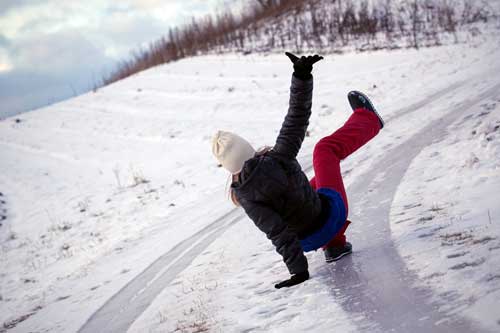We don't always think that walking is hazardous activity, but with winter upon us, it is one of the most hazardous tasks we do. Many winter hospitalizations in Canada are related to slips, trips and falls while walking. Between 2016 and 2017, the Canadian Institute for Health Information reported 8,864 hospitalizations due to falls on ice.
Icy conditions are not always easy to see when walking outdoors. For example, there may be a sheet of ice hidden under a layer of snow. Low temperatures can freeze air moisture or dew over a surface, creating a very thin layer of ice–more difficult to see, but still slippery. You should not assume that an outdoor surface is safe for walking just because ice and snow have been removed.
Walking on icy surfaces is dangerous because friction is reduced so you should use footwear that increases friction. For example, some brands of construction gear offer work boots that have grips and insulation which are specifically designed for the winter. With the combination of safety awareness and the right equipment, you can reduce the chance of slips, trips and falls on project sites.
In case you lose your balance, you should try to avoid a direct impact on your bones and instead, try to land with your hips or thighs. Landing with your arms stretched out is not advised, since you can easily break a bone. In case you fall backwards, you should curl your neck forward to prevent an impact on the back of your head. Also, thick winter clothing acts as a cushion and provides extra protection in case of a fall. Being aware of these tips will allow you to minimize the consequences should you have a fall.
Walk Cautiously on Ice and Snow
Slow and careful movements can greatly reduce the chance of a fall when walking on icy surfaces. Rushing can be extremely dangerous since you will have more kinetic energy if you trip. By taking your time you can avoid serious injuries, which are fatal in many cases. Under normal conditions, we walk with our center of gravity between both feet. Walking is a constant balancing act that we have learned to do unconsciously. However, icy conditions require a change in how we walk to prevent accidents. While it may sound like a joke, the best recommendation is “walking like a penguin”:
- Spread out your feet since this provides a wider area to support your center of gravity.
- Lean forward to support your weight with your front foot.
- Take short and slow steps, or shuffle forward.
Wear Proper Equipment
As mentioned above, you should use footwear with soles that increase friction, since this will reduce the chance of falling. Consider the following recommendations:
- Plastic and leather soles tend to slip more easily on icy conditions, while those made of rubber or neoprene composite offer the most stability.
- Shoes with heels should also be avoided, since they reduce the contact area with the floor. Footwear with flat soles is recommended to improve safety.
- You can also use attachable ice cleats for increased safety. Just make sure to remove them before entering a building, since they can damage floors and be slippery on tile floors.
On construction sites and other workplaces, the use of personal protective equipment (PPE) should continue normally, with the addition of proper footwear for the winter.

Stay on the Designated Path
When walking outdoors in the winter, resist the temptation of taking shortcuts over the snow or any other area where risks are not visible. You should be constantly analyzing the conditions ahead and planning your steps. For example, if a patch of ice is clearly visible ahead, you can find a safer spot to step on. Of course, you should also avoid distractions like answering a phone call or sending text messages. Avoid carrying heavy bags whenever possible, since they can affect your ability to keep balance on slippery surfaces.
Take Extra Care in Specific Instances
There are specific situations where icy surfaces are even more dangerous. For example, falling on stairs or ramps is likely when they are covered by ice or snow, since you have less control over your center of gravity. Take extra care at building entrances as melting snow or ice, since surfaces are even more slippery and likely to accumulate ice Getting out of your vehicle can be dangerous if you don’t check the surface you will step on. To avoid falling, you can hold on to the vehicle firmly for support. This situation is especially dangerous if you fall backward, since you can easily hit your head with the door frame.


 CAD
CAD USD
USD
When winter arrives and icy conditions prevail, your safety becomes paramount when traversing slippery surfaces. Ice cleats are your ultimate companion in maintaining stability and preventing slips and fall during activities such as walking, hiking, running, or working outdoors. These specialized traction devices are designed with rugged, durable materials and strategically placed metal spikes or gripping studs, ensuring excellent grip on icy or snowy terrain. With ice cleats, you can confidently navigate icy sidewalks, trails, driveways, or even frozen lakes, knowing that every step will be secure.